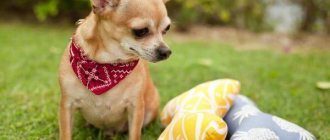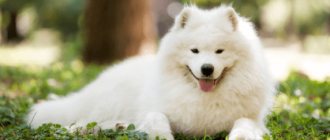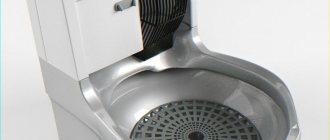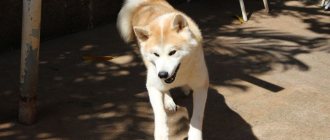Breed characteristics
| Short description | |
| Origin: | Switzerland |
| Conditions of detention: | Preferably a country house with a large plot |
| Purpose: | Rescuer; companion |
| Color: | White with red or red with white |
| Wool length: | Shorthair: 4-5 cm; long-haired 6-8 cm |
| Adult dog size: | The height of males is at least 70 cm, weight from 60 kg; bitches height from 65 cm, weight from 50 kg |
| Average life expectancy: | 9 – 11 years |
| Walk: | Daily walking required |
| Physical activity needs: | Average load requirements, walks 2 – 3 hours a day |
| Classification of the International Canine Federation (FCF): | Group 2 Pinschers and Schnauzers, Molossians, Mountain Dogs and Swiss Cattle Dogs; section 2 Molossians |
| Puppy price: | The average cost is 10,000 – 20,000 rubles, a show class puppy costs up to 55,000 rubles |
St. Bernard breed standards
| FCI classification | Group 2, Section 2.2 – Molossoid breeds. |
| Usage | Companion, escort, guard and yard dog. |
| Appearance | There are two types of Saint Bernards: short-haired and long-haired. Both have impressive sizes and strong, proportional bodies. The head is of impressive size, with a wary expression on the muzzle. |
| Basic proportions | The ratio of the height of the withers to the length of the body is 9:10. |
| Temperament, behavior | Calm, careful, friendly. |
| Head |
|
| Frame |
|
| Limbs |
|
| Movements | Wide smooth step. Characteristic movements of the legs are in one line. |
| Wool |
|
| Color | Background white with reddish-brown spots. Dark shades on the head are desirable. A slight black tint on the body, brindle, is allowed. |
| Height | Height at withers:
|
| Flaws | Deviation from the above parameters is a disadvantage. |
History of the origin of the species
The first mentions of St. Bernards came from the beginning of the 17th century. Alpine monks used large guard dogs to search for and rescue travelers lost in snowstorms from the snow. The ancestors of the Saint Bernard are considered to be mastiff-like and mastiff-like ancient dogs that followed the Roman legions as they passed north from the Alps.
It was the monks of the Augustinian monastery of St. Bernard who were the founders of the breed. Already since 1800, they were engaged in almost purebred breeding.
The most famous specimen was the St. Bernard, nicknamed Barry, who saved more than 40 people during his life. From then to this day, in every litter born at the monastery, there is a puppy named Barry.
Individuals from the 17th and 18th centuries were much smaller and lighter than the modern St. Bernard. The size of the breed was increased by crossing with Newfoundlands. From them came the long-haired representatives of the breed. Until this moment, there were only shorthaired ones.
In 1865, the breed received the official name - St. Bernard. And in 1884, the first official representative, nicknamed Leon, was entered into the stud book. Along with him there are 28 more individuals. On June 2, 1887, the first mandatory breed standard was drawn up. The last changes to the species specimen were made in 2004.
History of the breed
The Great St. Bernard has an eventful and factual history of origin. A breed of dog similar to the modern one first appeared in the middle of the 17th century. Experts suggest that dogs could have originated earlier. But there is no reliable information about this.
The painting by Italian artist Salvator Rosa (presumably the author) depicts a dog resembling a St. Bernard. The body structure of the animal on the canvas dated 1695 is similar. But the dimensions of the drawn dog are smaller. The dimensions in the image indicate the pet's relationship with smaller Mountain Dogs.
Literally, “Sennenhund” translates as “peasant dog.” The word appears in a number of Swiss rocks used by peasants for work. All pets belonging to this group have a tricolor color. Although scientists believe that dogs had a greater variety of coat colors in the past.
Looking at the Italian’s painting, specialist Albert Geim assessed the appearance of the depicted animal after 25 years of breeding work. Consequently, the breed originated around 1670. The established figure is approximate - an error of a couple of tens or even hundreds of years cannot be ruled out.
The history of the dog's name deserves special attention. The roots of the purebred pet lie in the monastery of St. Bernard (Saint-Bernard). The building was created in 980 and was located on the border of Switzerland and Italy. German lands were also located nearby. It was necessary to pass through the road, today called the Grand Saint-Bernard route, to reach these places.
Gradually, the mountain road became one of the most important trade routes. The only problem was harsh weather and frequent avalanches. At first, the St. Bernard dog was used for transportation and assistance in everyday life. But the monks noticed their pets’ uncanny (in their opinion) sense of avalanches. In reality, animals were simply able to hear at certain frequencies that were inaccessible to humans.
Distinctive features
The main distinguishing characteristics of St. Bernards are:
- General form. The dog is huge, strong, resilient and heavy. With the same huge head, proportional to the body.
- Head. Large, like the body, heavy, damp. With a wide protruding forehead, strongly protruding cheekbones. The transition from the forehead to the nose is significantly pronounced.
- Lips. Thick, hanging, loose. The upper jowls cover the lower jaw. Pigmented black, pink markings possible.
- Muzzle. Wide, short, smooth. Does not expand from nose to forehead. The bridge of the nose is slightly turned up or straight. The nose is large, with wide nostrils, and pigmented black. Scissor or pincer bite. Teeth set – 42 pieces.
- Neck. Powerful, muscular, shortened. It has a pronounced, massive dewlap, but without going overboard. The transition from neck to back is significantly pronounced.
- Frame. The shoulder blades are wide, muscular, and set obliquely. The chest is wide, not drooping, with prominent ribs. The back is wide, powerful, without sagging. The loin is voluminous, the croup is very well developed. Powerful, strong, strong thighs. The stomach is slightly tucked in.
- Tail. The base of the tail is at the level of the waist - set high. Heavy, long, wider at the base than at the end. Lowered, except in a state of excitement.
- Limbs. Well developed, muscular, straight and strong. Strong arched fingers, slightly closed. The paws are large, powerful with well-developed muscles.
- Coat and color. The coat is very thick, medium hard, and fits well to the body. There is a dense undercoat. On the thighs and tail the hairs are longer and thicker, but without dewlap. Red color, spots from reddish-brown to yellow. A white tip of the tail, paws, chest, “collar” or spot on the neck is considered obligatory. A black mask with a white stripe on the forehead is permitted.
Features of dogs
A clear feature is the size of the breed. The height of adult males varies from 70 cm to 90 cm, and the height of females reaches from 60 to 80 cm. As for weight characteristics, the smallest weight of St. Bernard dogs is 70 kg, and the largest can exceed 100 kg.
All Saint Bernards are quite large and strong in build. Like all other large dog breeds, the lifespan of St. Bernards ranges between 8 and 10 years.St. Bernard puppies are born quite dense, noticeably different from puppies of ordinary breeds. This is proven by photographs taken in real life of St. Bernard dogs and puppies.
Owners of such dogs must undergo surgery to remove the third eyelid, as it can grow over time and cause infectious eye diseases in the dog.
Saint Bernards can be divided into soft-haired and hard-haired individuals, but the body characteristics of Saint Bernards are similar:
- The head is large with a rather convex wrinkled forehead. High cheekbones and drooping eyelids are observed. The eyes have a brown iris;
- The ears are small;
- The neck has loose folds of skin that are associated with a tight collar;
- The back is wide, and the ribs can be clearly seen;
- The tail is heavy, thick at the center of the base, the tip of the tail is strong, but narrower;
Photo of an adult dog
Photos of puppies
Features of character and behavior
Saint Bernards are distinguished by their good-natured disposition, love and tenderness towards children. They are incredibly attached to people and are very bored when alone. Classified as wonderful companions, they are called nanny dogs. Despite its impressive dimensions, it is very neat.
You can safely leave even the smallest children with them, without fear that the dog will accidentally hit and knock down the baby.
There are some somewhat lazy and stubborn individuals, this is due to the mastiff genes infused by the British in the 19th century. But this does not prevent St. Bernards from being the favorites of their family and attracting the attention of others.
You should not expect from this breed the agility and activity of shepherd dogs. Due to their size and weight, these dogs are quite slow. But they will never give up playing outdoors, especially in winter. Thanks to their type of coat, representatives of this breed can easily withstand any weather, but in the south they are still hot, because they are mountain dogs.
Calm, even melancholic dogs, balanced and unperturbed. As a rule, silent. A barking St. Bernard is rather an exception. They rarely make good guard dogs, but with their gigantic size they can definitely scare off a stranger.
Advantages
St. Bernard is one continuous advantage. A giant with a kind heart. There are often cases when representatives of this breed saved the lives of their owners with their unique instincts. Either they anticipated bad weather, or they predicted in advance a jump in blood glucose in diabetics.
You can safely leave your children with this shaggy good fellow. Some even learned to walk by holding onto their pet's fur. These dogs have remarkable patience.
Flaws
The only drawback seems to be some stubbornness of St. Bernards, although you can also come to an agreement with them.
For those who want a guard monster, the St. Bernard is absolutely not suitable. Its direct purpose is to save people, not to attack them. With a complete lack of socialization, you can achieve some bitterness. But this is already a deviation in the psyche, and not the norm.
Distinctive features of the St. Bernard from the Moscow Watchdog
Modern St. Bernards are significantly different from the monastic dogs that lived with a lack of oxygen in a difficult climate.
However, their character has hardly changed. A well-mannered pet is confident and always remains calm. Young individuals are active and curious, and with age they acquire a phlegmatic character. They tolerate loads well and love snow.
Saint Bernards are often called a socialized breed. They love the company of people and suffer alone, so keeping them in an enclosure or on a leash is unacceptable. A huge dog can be a friend, companion and even a nanny. But the function of a watchman or security guard should not be assigned to him.
Important: Saint Bernards are a very good-natured breed of dog that almost never attacks people. They have high intelligence, comparable to shepherds and poodles. This breed is capable of learning, but is almost impossible to train. Attempts to make a St. Bernard a guard dog will only damage the psyche without bringing results.
In the 50s, the Soviet Union decided to breed a breed with high endurance and fidelity for guard duty. It was necessary to develop such parameters as ease of training, obedience, unpretentiousness and an innate tendency to protect.
to breed the Moscow Watchdog :
- Saint Bernard,
- russian hound,
- Caucasian Shepherd Dog.
The result was dogs that were similar in constitution to St. Bernard's dogs, but capable of guarding.
Externally, MCs have the following differences from Sens:
- shape of the skull – different inclination of the forehead relative to the muzzle, different position of the ears and eyes;
- lips and jowls, 3 types of bite are allowed in Sens;
- neck exit and back line;
- body composition and posture, angles of the limbs;
- coat color and density - MS may have specks, and Sens may have circles around the eyes.
However, the main difference is still the character of these dogs. Saint Bernards are always good-natured towards people and serve as a protector only from natural dangers.
The MS is a more aggressive breed, intended for a guard function. We can say that Sens are intended for home maintenance in the family, and MCs are intended for the role of watchmen.
Care and maintenance
Before you get yourself such a huge thing, you should think 10 times and rationally assess your strengths. A large, strong dog requires adequate space and nutrition.
It is highly undesirable to keep a St. Bernard in an apartment. In addition to drool and fur, it will occupy the entire space of a typical building. And not every resident of the metropolis will be able to walk the streets for 3 hours every day, in any weather. Large breeds need this for proper development of joints and tendons.
Excellent conditions for keeping a St. Bernard are a private house with a large garden. The only thing you need is to think in advance where the dog can hide from the scorching sun and rain. This shaggy good fellow is not afraid of frost and snow.
- Eye care requires careful attention due to slightly drooping lower eyelids . There is a risk that small particles will get there and the mucous membranes may dry out. To avoid possible complications, you should check your eyes every day. If necessary, rinse or instill with a special lotion.
- No special care is required for your ears ; it is enough to clean them once a month with a cotton swab moistened with an ear cleaning solution. Modern pet stores offer them in abundance.
- Nails should be trimmed as needed. If a dog often walks on asphalt roads, then, as a rule, they wear down on the rough surface. Otherwise, you need to buy special pliers and trim the claws yourself. This must be done very carefully, without damaging the living tissue on the inside of the claw. You can consult a veterinarian or groomer on this issue.
- Teeth require even less attention to themselves. During their change, you need to make sure that the dairy ones do not interfere with the indigenous ones. If necessary, go to the clinic and remove the excess ones, otherwise there is a risk of curvature of the molars. After about a year, the formation of tartar may begin, as a rule, this occurs due to poor nutrition. In this case, you need to have laser cleaning done by a veterinarian.
Nutrition
With all the good nature of these dogs, one should not forget that, first of all, they are a predator. Nutrition must be appropriate. Both in puppies and adults.
The diet must include:
- Meat
- By-products
- Eggs (whites)
- Cottage cheese (other fermented milk products)
- Complex carbohydrates (rice, oatmeal)
- Fresh vegetables
- Not very sweet fruits (apples)
Be sure to provide additional calcium, collagen or a complex of vitamins for especially large breeds. This is necessary for the proper development of joints.
There is a large number of ready-made foods, already fully balanced for the needs of a particular breed. They are also acceptable to feed the dog, but vitamins should not be neglected, especially with such a heavy breed as the St. Bernard.
The feeding schedule for a puppy and an adult dog varies greatly.
- A baby from 2 to 4 months should be fed 6 times a day.
- From 4 to 6 months 4 times a day.
- From 6 to 10 – 3 meals a day.
- From 10 months of age, you can switch to the diet of an adult dog - 2 times a day.
It is advisable to give a portion a little smaller in the morning than in the evening, since it is more difficult to move around with a full stomach.
We recommend that you read a detailed article on the topic: “How and what to feed a dog: types and characteristics of nutrition.”
Health
Unfortunately, the St. Bernard is not able to boast of excellent health. Huge body weight cannot but affect the joints and cardiovascular system.
During the development period, you need to carefully monitor the puppy. Too rapid growth in body size and weight can lead to exhaustion of the body, lack of minerals and calcium.
With a lack of calcium, the pasterns may sag under their own weight. When this happens, it is too late to give your puppy mountains of calcium. Thus, it will only get worse, the already separated paws will finally harden.
Recovery therapy should be started immediately. More walking up the stairs, going down the elevator. Walk on uneven surfaces such as gravel, crushed stone. Review your pet's diet; in case of such problems, it is definitely due to a lack of nutrients from the diet.
Vaccinations
Before giving the puppy the first vaccination, it is necessary to do helminth prevention; as a rule, this is done by the breeder.
- At the age of 4 - 6 weeks, the entire litter, together with the mother, is given a deworming drug. Even if the dogs have not been infected, the prophylaxis is repeated after 2 weeks.
- Only after twice the prevention of helminths is the first vaccination given.
- At the age of 6 - 8 weeks , they are given a vaccine against plague, hepatitis and enteritis.
- The next vaccination is given against the same diseases, after 4 weeks , consolidating the effect. By this time, it is already possible to give an injection against rabies, but if the puppy is growing up in “greenhouse” conditions, vaccination against rabies may be delayed for up to 6 months.
The entire period from birth to re-vaccination is subject to strict quarantine. Veterinarians recommend not going outside for another week after the last vaccine.
On the day of helminth prevention, as well as after vaccinations, puppies may be drowsy and lethargic. This is considered normal - the body is reacting to the drugs. Cases of intolerance to modern vaccines are rare.
The last puppy vaccination is given a year, against the above diseases. And every subsequent year they are duplicated along with rabies.
Important article on the topic: “Everything you need to know about dog vaccinations.”
Diseases
Saint Bernard is the hero of the dog world only in appearance; his great height and weight do not add to his health. A mastiff-like face contributes to eye diseases.
The most common diseases of this breed are:
- Dysplasia of the hip (elbow) joint.
- Intervertebral hernia.
- Inversion and inversion of the eyelid.
- Cardimopathy.
- Osteosarcoma.
- Pyoderma.
In addition, under excessive stress, puppies with a large mass are more susceptible to dislocations and ligament tears than others.
Don’t be afraid of such an extensive list; not all St. Bernards will necessarily be sick. With the right approach to breeding and raising a puppy, the chances of getting a strong, healthy pet increase several times.
Walk
Any dog needs a walk, this breed is no exception. Saint Bernards need long, leisurely walks in the fresh air. About 3 – 4 hours a day.
In the summer they quickly get tired, but in the winter they are ready to wander through the snowdrifts for a very long time.
Grooming
The coat of representatives of this breed does not cause much trouble. Even on long-haired individuals, it does not get tangled and does not require haircuts or frequent washing.
All that is needed is thorough weekly brushing with a fine-toothed brush. During the shedding period, it is advisable to comb the coat every day.
You should not wash these dogs too often so as not to disrupt natural heat exchange. Otherwise, they will be even hotter in the summer and colder in the winter.
For washing, it is recommended to use only special zoo shampoos. It is better not to bathe puppies under one year of age at all.
Character and habits of St. Bernard
Dogs of this breed are usually sweet and gentle. They are very patient with children and also get along well with other pets. Saint Bernards are very smart, they always strive to please their owner. At the same time, they are quite simple to learn and easy to train. By nature they are slow, thoughtful and phlegmatic, as well as unusually strong and have an excellent sense of smell, and are well oriented in space. They will easily find their way back, no matter how far they wander. Such dogs have a particularly developed need to be part of the family: they need regular communication with people, they do not tolerate loneliness and lack of attention to themselves. Abandoned puppies of this breed suffer from depression, which can even cause injury to themselves.
Mating
Such large dogs are bred when they reach the age of two, not earlier. These are quite late dogs, and at one and a half years old they are a playful 70 kilogram puppy.
To avoid health problems, you need to wait until the bones are fully formed. Otherwise, the mother’s sagging back and problems with childbirth cannot be avoided. Difficulties with the health of the offspring cannot be ruled out.
Bitches ovulate approximately 10–14 days after the onset of estrus. During this period, an appointment is made with the male dog. These data are approximate and may vary depending on the characteristics of the organism.
Read a detailed article on the topic: “Everything you need to know about breeding dogs: appropriate age, what to do if it doesn’t work out, rules and tips.”
Today, veterinary clinics can take an analysis to determine whether a female dog is ready for breeding. The male is ready to breed all year round.
Conditions for keeping St. Bernard
The first thing to consider when purchasing a dog of this breed is whether you can accommodate such a large animal in your apartment and give it enough attention for a comfortable pastime and physical development.
In general, the St. Bernard requires standard care for dogs of similar breeds: brushing several times a week with a stiff-bristled brush is sufficient, bathing only when necessary, using a mild dog shampoo. During shedding, it is recommended to brush your dog more often than usual. You should periodically wipe your dog's eyes and mouth after each meal. For eye inflammation, it is necessary to use tetracycline ointment. It is worth regularly inspecting and cleaning your pet's ears and teeth. In addition, the St. Bernard needs daily long walks, as well as regular physical activity. Dogs of this breed are prone to overheating, so you should be especially vigilant in hot weather. When properly maintained, a healthy dog usually lives 8-10 years.
Key points in training
Raising a St. Bernard is not difficult; he loves his owner and tries to please. But due to its innate stubbornness, training needs to be done from the first day the puppy is in the house. It will be more difficult with an adult dog.
Parenting must be approached gently but persistently. Show creativity to interest your pet in training. As soon as the St. Bernard understands the benefits of training, his remarkable intelligence and intelligence will immediately appear.
Under no circumstances should you beat or punish a dog if it does not immediately understand what the owner wants. In this way, you can only achieve complete rejection of the desire to work and serve the owner.
Due to their breed characteristics, these dogs are perfect for training search and rescue services. They no longer operate in the Alps; searching for people by helicopter is much more effective. But the mighty, strong dog is still ready to serve people, helping rescuers find victims of the elements in the rubble of buildings after earthquakes and fires.
Read about how to properly train a dog in the article: “Training a puppy: effective methods from dog handlers, learning commands at home.”
Training
Thanks to its characteristics, St. Bernard easily follows commands. Lessons are possible both with the owner and with a specialist.
Training must begin from the first days of acquaintance. At a young age, kids are spoiled, but as an adult it is difficult to unlearn previously established habits:
- It is necessary to correct his behavior in the house and on the street;
- Accustom to society;
- Prohibit spoiling and scattering things, which they love very much;
- Teach cleanliness;
- Do everything gradually and with great patience. There is no need to punish a child, but it is important to encourage him;
- It is strictly forbidden to keep him on a leash, but you can use a leash during walks.
After just a couple of months of training, the baby will begin to delight the owner with his new skills.
How to choose a puppy
The choice of a future pet must be approached with all responsibility. The first thing you need to do is decide on a nursery. Selecting a breeder is no less important a step than choosing a puppy. Conscientious nursery owners always accompany their charges throughout their lives. They help owners select food and ammunition, and supervise at exhibitions.
Under no circumstances should you skimp on your dog. No breeder will sell a good puppy at a reduced price. To get healthy offspring, a lot of effort and finances are invested. Therefore, you should be wary if the seller offers an “elite” puppy for a symbolic amount.
All puppies in the litter must be strong, playful, and healthy. Self-confident, not afraid of strangers or sharp sounds - this is a guarantee of a strong nervous system. Have a moderate appetite. Lively curiosity, like all children.
Under no circumstances should there be any discharge or foreign odors from the eyes, nose, or ears. The presence of fleas, lice eaters and other parasites is unacceptable.
A prerequisite is the demonstration of both parents, and even better, other relatives . There should be no lame, neglected, sick dogs in the family.
The Saint Bernard is a dog with a big heart. It was not for nothing that the monks brought them out, because both of them had a calling to help people. This is the personification of love, dedication, tenderness and devotion. A dog is the savior of the human soul.
Mating and choosing a puppy
Due to the fact that the life expectancy of the breed is not long, puberty occurs quite quickly, and the first heat in females occurs as early as 8-9 months. This, of course, does not mean that it is worth starting the process of reproducing puppies; the female’s body must get stronger before bearing a new litter. The ideal time for the first mating is considered to be two years of age for females and two and a half years for males. After reaching eight years of age, representatives of the St. Bernard breed are not allowed to replenish the population.
In cases where veterinarians determine that a female’s pregnancy is multiply, then during childbirth it is better to play it safe and invite a specialist. The place for whelping should also be prepared in advance so that the bitch gets used to it and feels completely calm during the birth process.
Choosing a puppy in terms of its activity and health is no different from the process of choosing other breeds. An active puppy with good fur and not too chubby are the main criteria for choosing a future pet. But if you are looking to purchase a dog for a show career or for further breeding, additionally evaluate the puppy’s exterior, pay attention to its consistency and color.
The price of a puppy consists of many factors; it is important for what purposes you are purchasing a baby St. Bernard and what qualities the breeder himself focuses on when breeding. The breed is not widespread and requires significant material costs to maintain, so do not try to find a healthy and purebred St. Bernard through private advertisements.
The price range for St. Bernard crumbs is wide:
- Puppies that are not allowed for mating and exhibitions cost from 7,000 to 35,000 rubles, this is how much a St. Bernard will cost exclusively for the home,
- A puppy with minor defects in appearance, which does not have congenital prerequisites for hereditary diseases, will cost from 40,000 to 60,000 rubles,
- An “ideal” puppy, the so-called “Show-class”, will cost from 70,000 rubles and above. With such a St. Bernard, you can participate in exhibitions from an early puppy age, and finding a mating partner will not be difficult.
When getting a St. Bernard, you should weigh the pros and cons, evaluate your ability to provide for the dog and the opportunity to give it space to live. The good-natured giant will undoubtedly become a friend to all household members, but at the same time he is completely incapable of becoming a security guard, but gets along well with children, causes a lot of trouble with his size, but is absolutely affectionate and kind.











